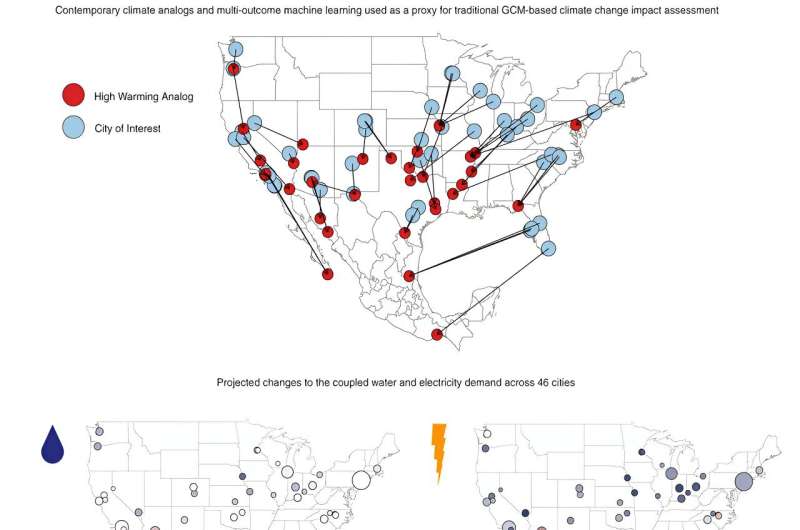November 14, 2023 report
This article has been reviewed according to Science X's editorial process and policies. Editors have highlighted the following attributes while ensuring the content's credibility:
fact-checked
peer-reviewed publication
trusted source
proofread
Using AI to estimate future water and electricity demands in major cities in light of global warming

A multi-institutional team of industrial engineers has used AI technology to make projections of increased demand for electricity and water due to climate change in major cities across the U.S. In their study, published open access in the journal One Earth, the group trained an AI system with both climate data and electricity and water usage statistics for 46 major cities in the U.S.
As climate change progresses, scientists around the world continue to try to predict what will happen as temperatures rise and weather conditions and events change. For this new study, the research team wanted to make estimations regarding likely increases in electricity and water demands in major U.S. cities between now and 2080.
The researchers began with the assumption that both electricity and water demands will increase in most major cities in the U.S. due to the need to use more water to maintain green areas, such as residential lawns and New York's Central Park, as temperatures rise. Similarly, higher temperatures will likely mean increased electricity demand in the summer as air conditioner installations increase.
To make their estimations, the researchers collected climate data for the years 2007 to 2018 for 46 of the largest cities in the U.S. They trained an AI system with the data in order to make estimations of temperature increases for all the same cities for the coming years. Next, they collected water and electricity usage data for the same cities over the same period of time.
They then used the AI results along with the data they collected to create estimations of future water and electricity demands for the same cities by 2080. The team also used climate analogs in which city utility demands are compared between cities today, and those expected to experience similar climate changes in the future. For example, New York is projected to have conditions in the future similar to those of Jonesboro, Arkansas today. Making such comparisons allows for extrapolating utility demands for future city needs.
Taken together, the research team found, as expected, that most U.S. cities will see an increase in demand for both water and electricity. But they also found exceptions—Los Angeles and New York, for example, are not likely to see much of an increase in water use, at least per capita. They also found that some Gulf Coast cities may actually see reductions in water and electricity use due to projected increases in rainfall amounts.
More information: Renee Obringer et al, Contemporary climate analogs project strong regional differences in the future water and electricity demand across US cities, One Earth (2023). DOI: 10.1016/j.oneear.2023.10.004
Journal information: One Earth
© 2023 Science X Network




















